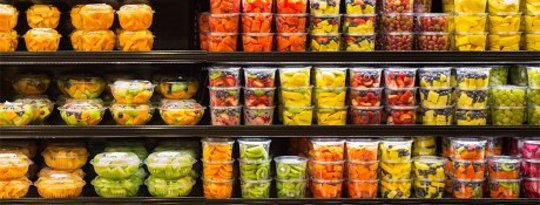 Environmental chemicals are wreaking havoc to last a lifetime. 10 to 15 percent of all babies born in the U.S. have some type of neurobehavorial development disorder. Still more are affected by neurological disorders that don’t rise to the level of clinical diagnosis.
Environmental chemicals are wreaking havoc to last a lifetime. 10 to 15 percent of all babies born in the U.S. have some type of neurobehavorial development disorder. Still more are affected by neurological disorders that don’t rise to the level of clinical diagnosis.

Purchase a plastic water bottle, and there’s a good chance that it will feature a “BPA-free” label. You might be seeing it more often because the industrial chemical Bisphenol-A has now been removed from a wide array of products.

As average temperatures rise an increasing global population – with many more elderly people – is going to be more vulnerable to extreme weather, UK scientists say.

Bad news for hay fever and asthma sufferers as US researchers demonstrate that man-made rises in CO2 emissions could lead to a 200% increase in the levels of pollen from grasses.
o
Recent analyses raise disturbing questions about the health and environmental effects of the stuff that encases our edibles.
- By Ed Brown

Today, chemicals comprise the backbone of our modern lifestyle and are the largest sector of our economy. We generate 300 billion pounds of synthetic chemicals each year in the U.S. alone, and an average American uses more than 1,500 pounds of chemical products. Synthetic chemicals are poisoning our bodies...
 Toxicologists have a saying: “The dose makes the poison.” In other words, there is no such thing as “toxic” or “non-toxic” — it always depends on how much of a substance you consume.
Toxicologists have a saying: “The dose makes the poison.” In other words, there is no such thing as “toxic” or “non-toxic” — it always depends on how much of a substance you consume.

On a low, windswept rise at the southeastern edge of the Navajo Nation, Jackie Bell-Jefferson prepares to move her family from their home. A mound of uranium-laden waste the size of several football fields, covered with a thin veneer of gravel, dominates the view from her front door...

It would seem, and particularly for mothers, fathers, and grandparents everywhere, that using plastics for anything other than decorations is not at all wise. Just what would be your decision if you knew that what you were feeding your children, or your grandchildren, might one day lead to...

As a new report highlights the link between warming waters and mercury pollution, scientists fear for contamination to the marine food chain. Scientists in the US say they have found evidence suggesting that warmer sea surface temperatures may increase the ability of fish to accumulate mercury.

The health risks of leaded gasoline are a thing of the past, right? Wrong. When the Oregon Department of Environmental Quality surveyed the airport in 2005, it found a lead cloud hovering above Hillsboro, a circular plume spanning 25 square miles. At its center lead levels were twice as high as the National Ambient Air Quality Standard threshold...
 Our primal mind has no defense against the stressful world it now faces, and we are paying a terrifying price for it. The toll this takes is insidious as well as profound, and it must be appreciated if steps are to be taken to mitigate its effects...
Our primal mind has no defense against the stressful world it now faces, and we are paying a terrifying price for it. The toll this takes is insidious as well as profound, and it must be appreciated if steps are to be taken to mitigate its effects...

Many older people in the U. S. population were chronically exposed to lead from paint and gasoline prior to the 1980s. To date, most of the research on lead and cognitive functioning in older age has focused on men, despite the fact that women live longer on average and therefore may be more likely to develop dementia over the course of their life span.

Bacterial communities called biofilms can quickly clog medical devices such as stents and catheters by forming 3-dimensional streamers that block flow. The finding will inform future approaches to prevent these deadly clogs....

The idle fields are illuminated by lights from his house, where several men bend intently over a low wooden table as they pore over satellite photographs and contour maps.

A low-cost vaccine against the dengue virus showed promise in an early-stage clinical trial. With further development, the vaccine may help ease the burden of dengue fever in developing countries....
- By John Robbins

There are legitimate questions about soy. To my mind, by far the most disturbing one stems from the fact that 90 percent of the U.S. soybean crop today is genetically engineered. Because so much Roundup is used on these crops, the residue levels in the harvested crops greatly exceed what, until very recently, was the allowable legal limit...
- By Deanna Duke

(Do you think your tap water is only water? Think again.) The major contaminants that the EPA requires testing for include benzenes, vinyl chloride, BPA, triclosan, DEET, mercury, cadmium, perchlorate, phthalates, DDT, PCBs, atrazine and other pesticides, E. coli and fecal coliforms. Other contaminants...
- By Deanna Duke

Back in the 1980s, NASA reported some research it did on the value of indoor plants in cleaning up air quality. Over the years, researchers looked at more than 30 different plants to find the ones that are best at cleaning indoor air...

Women show more susceptibility to toxins. On one hand, women’s bodies have more fat, where toxins accumulate, so women are four times more likely to exhibit symptoms of chemical sensitivity than men.

BPA is in many of the products we eat and drink regularly. It is so common that the CDC estimates that 93% of Americans have BPA in their bloodstream. One of the most common products containing BPA and the one of most concern is canned food.
- By R Jennings
 Last week, the Mercury and Air Toxics Standards was finalized and will protect millions of families and, especially, children from air pollution. Before this rule, there were no national standards that limited the amount of mercury, arsenic, chromium, nickel and acid gases power plants across the country could release into the air we breathe.
Last week, the Mercury and Air Toxics Standards was finalized and will protect millions of families and, especially, children from air pollution. Before this rule, there were no national standards that limited the amount of mercury, arsenic, chromium, nickel and acid gases power plants across the country could release into the air we breathe.
We are living in a world where environmental pollution has become part of life. Civilized humans today must live in cramped urban areas, drink contaminated water, take in polluted air, eat contaminated foods, and endure loud, disturbing noises. What can we do?















